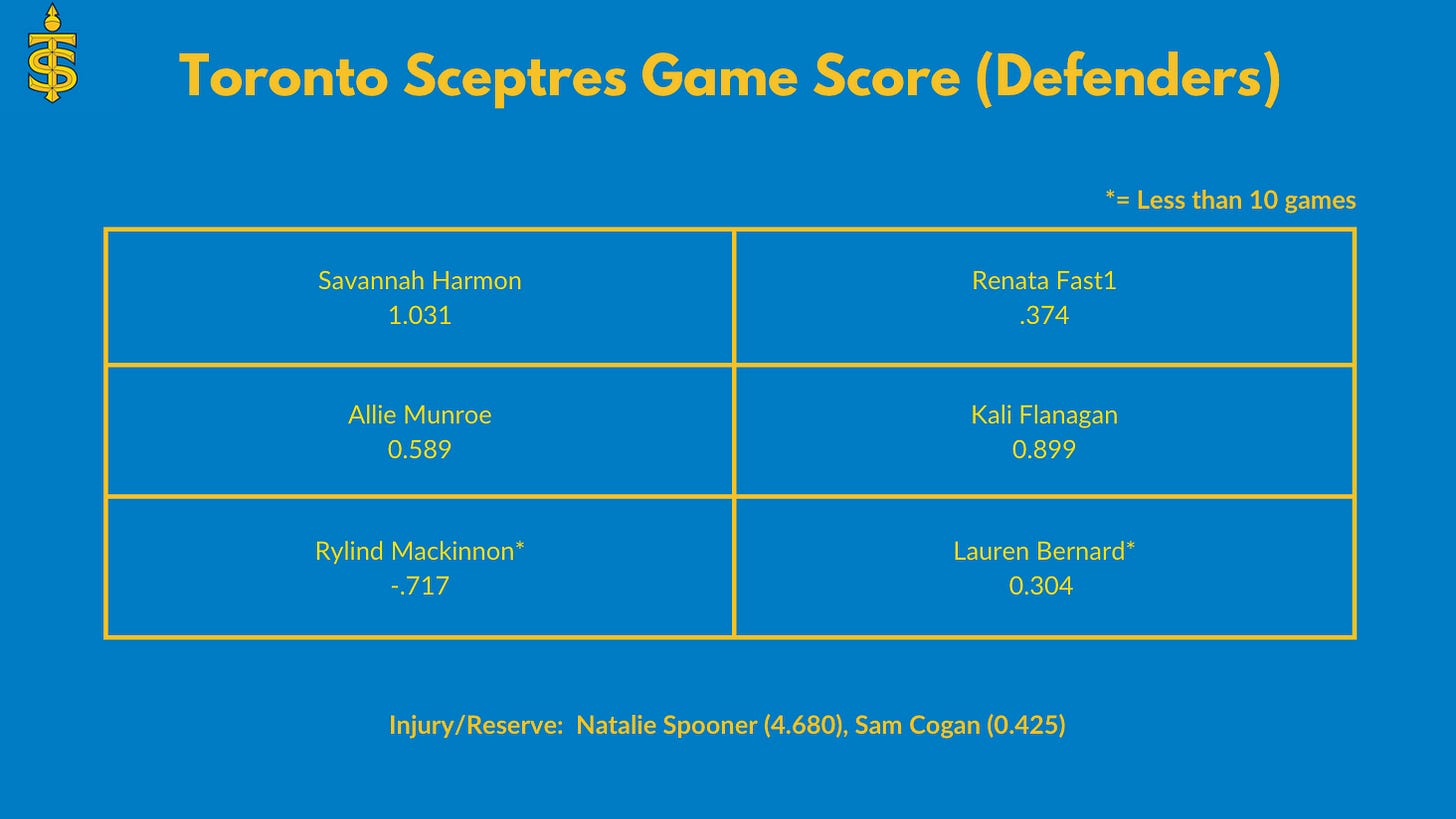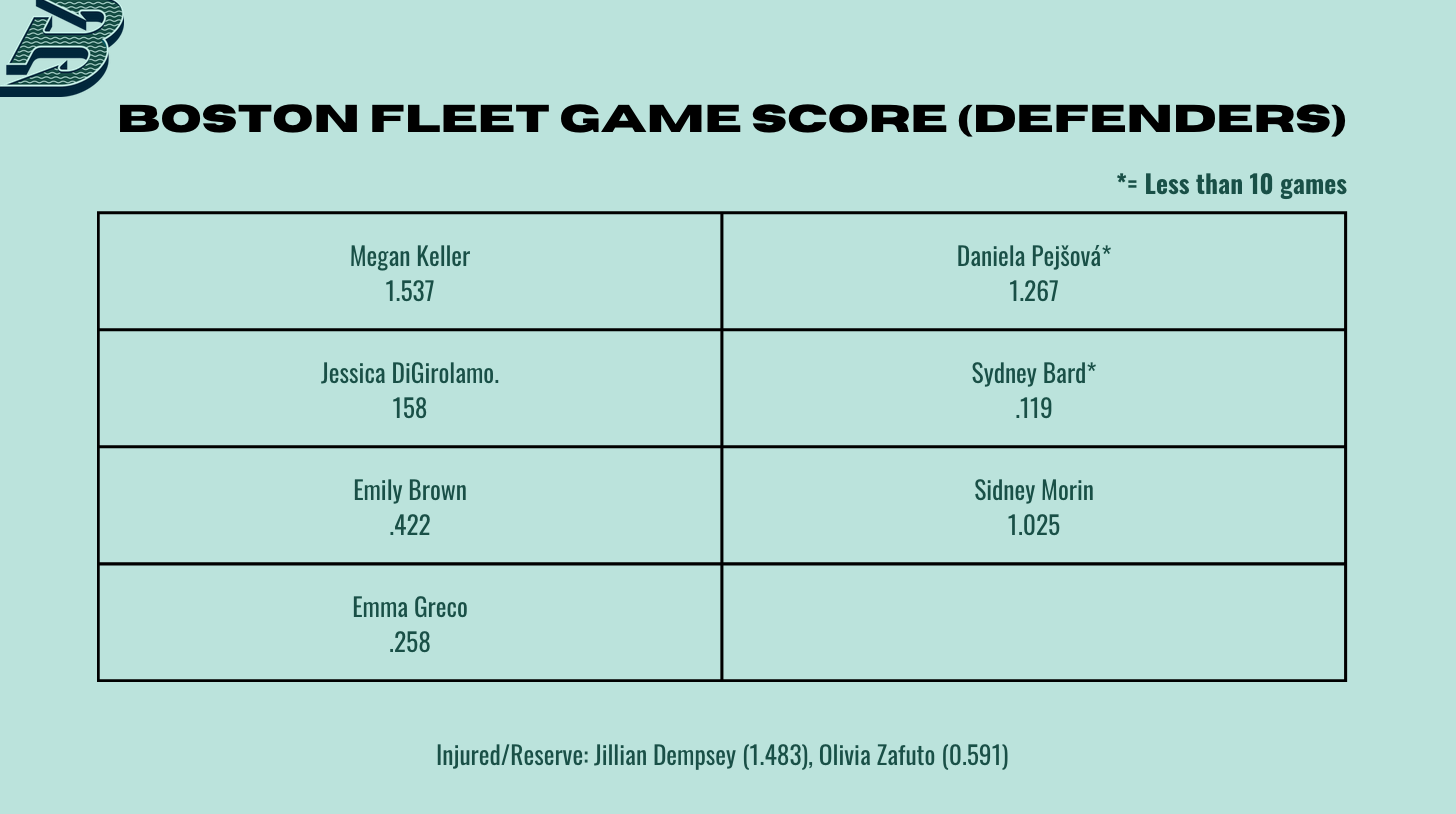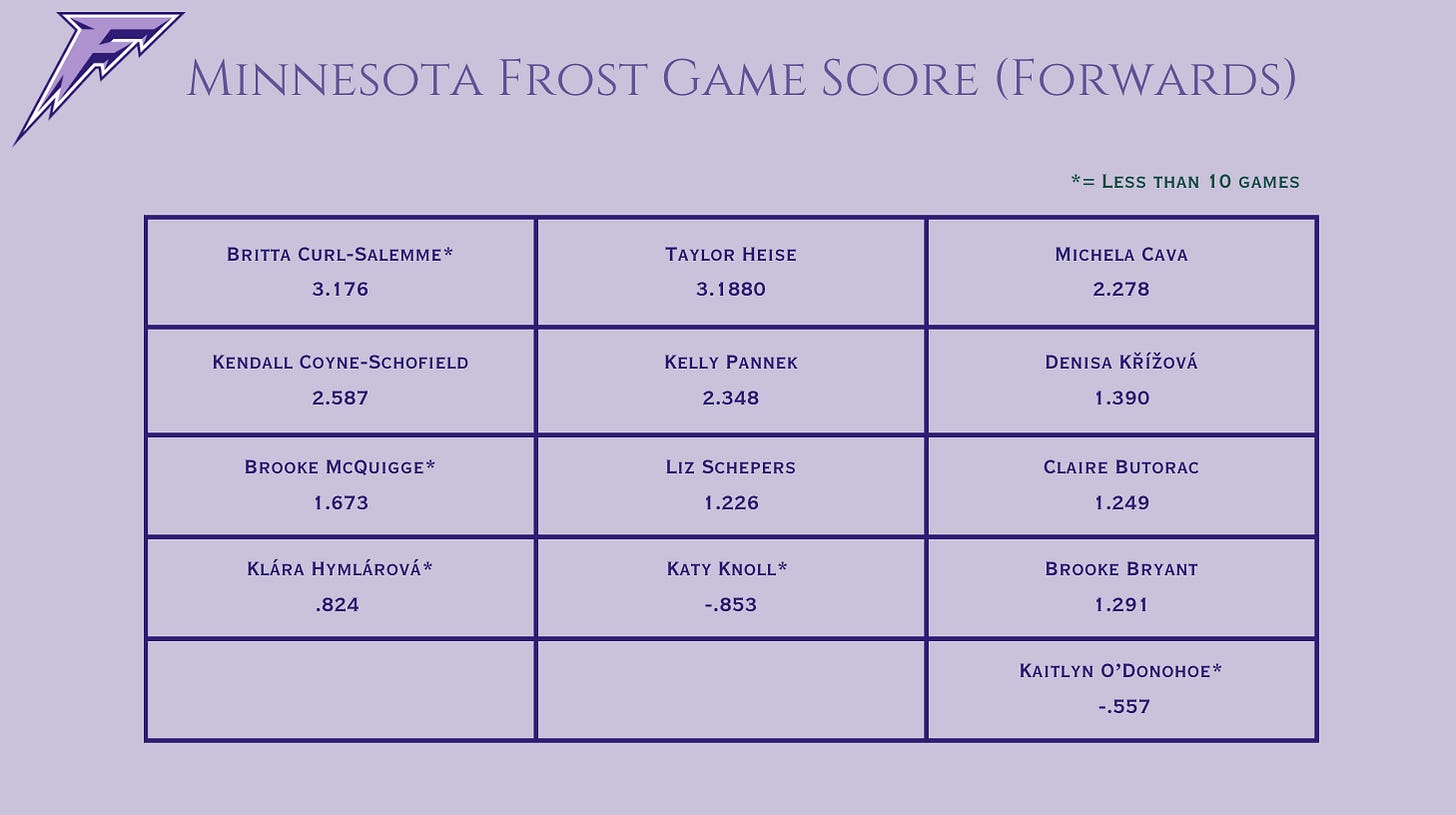Creating Game Score for the PWHL
Developing a formula for Game Score based on publicly available PWHL statistics and what they do - or don't - tell us about each roster
If you’ve been following hockey for a while and are active on social media, you’ve probably seen an image that looks something like this:
Hockeystatcards.com, Carolina Hurricanes Game Score on 1/15/2025
Game Score is a way to see a player's impact on a game by providing a weight of significance to different outcomes/actions including but not limited to goals, assists, penalties, and face offs. After collecting enough instances of Game Score over time, that data can be used to measure a player's average impact on a game per 60 minutes of their ice time.
Dom Luszczyszyn’s article Measuring Single Game Productivity:An Introduction to Game Score is the basis of the hockey application of Game Score. Originally used in basketball and baseball, Luszczyszyn describes the statistic as “meant to answer “who had the best game” by adding proper perspective to a combination of a player’s total contributions and into an easily understood all-in-one stat.” Currently, the website Hockeystatcards is the most popular website for Game Score, using an interpretation of Luszczyszyn’s formula and NaturalStatTricks data to build Game Score visualization.
In the 2018 article An Introduction to NWHL Game Score, Shawn Ferris modified game score for the NWHL, in order to adjust for what statistics were kept in the NWHL. Ferris puts an emphasis on this being a way to evaluate contribution for a NWHL player rather than performance, due to the statistics being more limited. The weights for each factor are different than Dom’s, due to the different scoring environments for the NWHL compared to the NHL and the difference in publicly tracked data.
Building A Formula
In order to build a formula for PWHL Game Score, I found most of my data either from PWHL box scores using the FastRHockey package by Ben Howell and Salem Gilani. Data gathered by Hockey-Statistics from their Game Data file helped fill in some gaps missing from the PWHL standard box scores, such as separating assists into primary and secondary categories.
The statistics I used were: Goals, primary assists, secondary assists, shots on goals, penalties taken, face offs won, face offs lost, and even strength goal differential at the conclusion of the game. Similar to Luszczyszyn and Ferris, most weights were calculated by comparing their frequency to goals scored in the league. For example, 507 goals and 6070 shots lead to a weight of .0835. For penalties, I used Ferris’s method of comparing instances of penalties taken to power play goals scored. Here is how our formula for the PWHL compares to Luszczyszyn’z and Ferris’s.
NHL Player Game Score from Dom Luszczyszyn = (0.75 * G) + (0.7 * A1) + (0.55 * A2) + (0.075 * SOG) + (0.05 * BLK) + (0.15 * PD) – (0.15 * PT) + (0.01 * FOW) – (0.01 * FOL) + (0.15 * GF) – (0.15* GA)
NWHL game score from Shawn Ferris: Skater = G + (.64*A) + (.11*SOG) + (.12*FOW) – (.12*FOL) – (.17*PEN)
My PWHL Game Score = Goal + (0.911 * A1) + (0.69 * A2) + (0.0835* SOG) - (0.15 * PEN) + (0.045 * FOW) – (0.045 * FOL) + (0.19 * PlusMinus)
Limitations and Notes:
This is not intended to be an all encompassing way to evaluate a player's talents or role on their team, nor should it be. It is just one of the many angles to evaluate a player’s contributions in each of the games they’ve played. Some limitations include:
For this article today, I am doing skaters only.
Game Score is heavily offense based, so it does tend to underrate shutdown defenders such as Lee Stecklein.
The PWHL hasn’t played many games as a league yet, so all players are operating on a small sample size when looking at their average game score over all PWHL games.
Unlike in Luszczyszyn’s NHL version of Game Score, plus minus is at all strengths, so penalty killers who are not on the power play unit are inherently going to suffer and forwards who only play the power play are going to benefit. Additionally, this data only includes a player’ +/- total at the conclusion of the game and not each individual instance of being on ice during a goal for or against,
Game misconducts can pretty drastically tank a player's game score (you will see this with Rylind Mackinnon, for example, despite several games with above league average game score.) Centers are favored over wingers due to the face off aspect.
As mentioned by Luszczyszyn, basic Game Score is a contextless statistic, meaning “Teammates, competition, score, pace, zone starts, playing time, special teams time, team effects” are not accounted for. Hockeystatcards has started to build out their version of Game Score to include more context and hopefully soon we will have the public data available to do that for the PWHL
We do not have corsi or the shot total for and against while a player is on ice (not including the shots they take) which makes it harder to see the “negative” impact. This Game Score is more similar to Ferris’s in that sense, as it is more measuring contribution than anything else. My dream is to, one day, have on-ice expected goal statistics available for women’s hockey.
Blocks were not included, but one could technically tally blocks for a game in the PWHL play by play data, it’s just not in the box score and thus not included here
The original Game Score formula scales down all the weights to make it look like points, but the NWHL one does not, and this PWHL one won’t either.
Please, Just Show Me The Numbers Already
All Skater Median Game Score per 60 minutes of TOI: 1.040
Defender Average Game Score per 60 minutes of TOI: .673
Forward Average Game Score per 60 minutes of TOI: 1.381
Highest single-game Game Score: 4.089
Lowest single-game Game Score: -2.4
Median single-game Game Score: 0.083
Below is an example of what nightly game score would look like in this formula, first with the Charge and Sirens. Mind the adjusted X axis in each graph for Emily Clark’s amazing night.
Best individual games by Game Score:
Claire Thompson: 12/19/2024 vs. Ottawa, 1 goal 3 primary assists 2 shots + 1 in 22:55 TOI for 4.09 TOI for 4.01 Game Score 4.089
Taylor Heise: 5/19/2024 Playoff game vs Boston 2 goals 1 assist 5 shots +3 in 20:15 TOI for 3.976 Game Score (Fun fact, Michela Cava’s performance from the same game is #13 all time with a 3.641 game score, her two assists not being primary assists is the big difference.)
Claire Dalton 2/24/2024, vs. Ottawa, hat trick and +3 with 4 shots in 16 minutes fr 3.904 Game score
Even in this, you can see the strengths and weaknesses of the statistic. It helps us isolate the impact between Heise’s and Cava’s strong performances in each of their games, but also ranks Thompson’s performance over Heise because it currently doesn’t account for Thompson’s final assist being a empty net goal.
Average Game Scores for Each Roster
Below is the average game score per 60 minutes of ice time for of each player in the team's lineups. Average includes all games including last year's playoffs and regular season, and will include games from when a player was on a different team, if applicable.
*= less than ten GP, so take the averages for what they are: an average of their impact on games in their short PWHL career thus far, extremely vulnerable to outliers.
Toronto Sceptres
Takeaways:
As said above, Rylind MacKinnon hasn’t played many games (7) and her game score has been tanked by her game misconduct and suspension. Still, she had an individual game where her game score was a .967 (November 30th), and one with a .801 (December 7th.)
A lot of the current problems for this team, besides missing the MVP of the league, is trying to figure out how to fit their best players and put them in a position to produce and trying to get Daniels and Gosling going. The addition of Scamurra should help, but will require veterans like Blayre Turnbull to step up.
Boston Fleet
Takeaways:
Bilka has been the only player producing like a high-end offensive superstar consistently during her tenure in Boston, although Knight’s Game Score is weighed down by first year injury struggles that had her scoring less than normal. Both Knight and Tapani have both played more to their full potential, with one of Knight’s best games by Game Scoring coming on January 2nd with a goal, assist, and five shots for a 2.154 Game Score. The same game saw Tapani with her highest Game Score as a member of the Fleet, with two goals and three shots that gave her a Game Score of 2.329.
Their fourth liners grade out high offensively, but many of them are seeing a lot of power play time and not as much penalty kill time (Girard, Gabel, Adzija) which is a little unusual for a team’s fourth line and why they stand out. The Fleet experience a big dropoff in terms of offensive contributions from their defenders after their first pairing of Keller and Pejšová. Bard, Brown, and DiGirolamo are all shutdown defenders who aren’t going to see their overall impact on the game measured by GameScore, but the Fleet will still need to see a little more offense generated from their defensive depth if they want to make a playoff push.
Also, Jillian Dempsey still rules.
Minnesota Frost
Takeaways:
A lot of Minnesota’s success can be thanked to their well constructed defense core. Jaques and Thompson are two of the best offensive defenders, and balanced out by Stecklein (who’s probably the best shutdown defender in the league), Channell, and Flaherty.
By Game Score, Minnesota has the best forward group and the best forward depth, so much so that missing a highly impactful Grace Zumwinkle hasn’t slowed them down. A few things have led to their success: the first is that the “core” they started out with and thus have the highest cap hit (Kendall Coyne Schofield, Lee Stecklein, Nicole Hensley, Taylor Heise, Kelly Pannek, Grace Zumwinkle) has been the most productive as a whole out of any team. While their inaugural draft wasn’t flawless, they were able to build out the remainder of their top six with two fairly late round picks - Denisa Křížová in round eight, and Michela Cava in round twelve. They found similar late round success in this year's draft, particularly with Brooke McQuigge and Dominique Petrie (who is a bit of an anomaly, as she’s in that under five game range but scored in three of those five games.) Finally, they grabbed Bryant, who’s one of the best fourth liners in the game, on a camp invite.
Montréal Victoire
Takeaways:
Injuries have hit hard, but Montreal has shown they have the depth to handle it. Gardiner has been everything they could have asked for, as has Barnes. Wilgren, a fifth round pick, has exceeded expectations.
Similar to Minnesota, Montreal has a lot of offensively capable defenders who give their offense a boost and have found talent through a few different pipelines to craft a solid lineup. Alexandra Labelle has secured a nice spot on the team’s third line and has been a great offseason signing for them. She’s played several of her best games with Montréal, including her game against the Frost on December 28th, where she had a goal, two shots, and went 7-for-11 on face offs. The fourth line could use a boost, but if Murphy gets back to more regular playing time and Marchment returns, that problem will solve itself.
On defense, Dominika Lásková’s Game Score is missing some context - she only played seven games just when the league was starting, and has been injured since. Despite her absence, the Victoire currently have one of the most impactful defense squads in the league right now, alongside Minnesota. Anna Wilgren, who was drafted in the fifth round, has had a strong start through eight games.
New York Sirens
Takeaway:
This NY team is weird.
This team has a good first line (I’m going to say Eldridge is essentially LW1, even though she’s been playing down the lineup to spread out the scoring) and a good bottom six in terms of having decent hockey players you can trust in their zone, but hasn’t found its secondary scoring yet. The key for that may be within, if they can get Abby Roque and Elizabeth Giguère going. Roque has been good, but we know she can be great, and there is another level to unlock there. Tulus is another potential solution as she continues to adjust to her new league and team. This team badly needs some defensive depth, and the lack of reserves available in New York is a problem.
I also love how this shows how interesting a player Jade Downie-Landry is. She is probably slightly overrated for this system, but it’s also a result of the fact that, once in every 10 games or so, she will suddenly be the best player on the planet and completely take over. Most of her game scores fall between 0-1, but she also had about three games in which she posted some of the highest Game Scores recorded in the leagues: Her hat trick game last January against the Fleet, her two goal one assist game last March against the Fleet, and a game at the beginning of this season against Montreal where she had a goal, three shots, and went 4-for-7 in face offs.
Vespa’s is effected by the fact that she typically sees around five minutes of ice time when she plays, but has been very effective in that time.
Ottawa Charge
Takeaways:
First, I want to point out that Tereza Vanišová has gotten a game misconduct in two separate games which was a major hit to her average Game Score, so I definitely thought her overall average would be lower than it is. A positive sign that her production is good when she stays out of the penalty box.
Ottawa badly needs one more key piece on offense outside of Clark and Jenner, though rookie Serdachny has a high ceiling and the potential to be one. Katerina Mrázová, Tereza Vanišová, and Victoria Bach are all good - even great - pieces to provide secondary scoring, but an elite center would go a long way and Serdachny is their current best shot at it. However, a lot of their scoring woes can be tied to their offense and the fact that the puck-moving defenders they’ve signed like Jincy Roese haven’t been able to make a consistent significant offensive impact, though she has contributed in other parts of the game. Ronja Savolainen was drafted to provide more scoring from the blue line and, like Serdachny, should be able to reach her ceiling with more time in the league.
The front office staff of the Charge also need to examine if they are doing everything they can to enable these players to reach their potential. One problem is a lack of clear vision for this team in terms of roster building. The Charge have let several players go who’ve gone on to show they could have been exactly what they need, in the right circumstances: They let Mikyla Grant-Mentis go for nothing, which left them down a winger and forced them into a position where they had to acquire Tereza Vanišová for Amanda Boulier. While Vanišová has been great for the Charge (and is one of my favorite players in the league) the domino effect of letting another great winger go and having to give up a puck-moving defender the team needed to fill that spot is bad asset management. They were lucky enough to get Daryl Watts in the sixth round of the expansion draft, but couldn’t retain her and lost her for nothing. The roster has a ton of talent, but they’ll need the management to put them in a position to succeed
Conclusion:
Consider the Game Score you see her an official -1.0 version of what this could be for the PWHL in term of public sphere analytics, and please take a moment to check out all of the work that was linked in this piece. Hockey-Statistics in particular has been phenomenal in terms of creating a public data base of PWHL statistics and calculating some individual expected goal numers and tracking shots.


















Great work! I enjoyed the read and it is fantastic to see more folks taking an interest in player evaluation. In case you missed it, I did some work building off of Shawn's first NWHL formula in 2019 and some have used it as an imperfect formula over the last several seasons.
https://hockey-graphs.com/2019/08/21/revisiting-nwhl-game-score/
Given the data that is publicly available now, we can do a lot of exciting work with rate statistics that just wasn't a possibility before the PWHL kicked off. It's a really exciting time to dig into all of this.